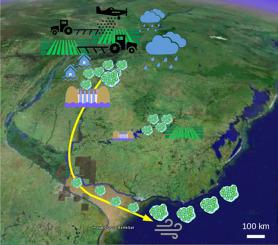Science of the Total Environment ( IF 8.2 ) Pub Date : 2020-09-16 , DOI: 10.1016/j.scitotenv.2020.142362 Carla Kruk , Ana Martínez , Gabriela Martínez de la Escalera , Romina Trinchin , Gastón Manta , Angel M. Segura , Claudia Piccini , Beatriz Brena , Beatriz Yannicelli , Graciela Fabiano , Danilo Calliari

|
Cyanobacterial toxic blooms are a worldwide problem. The Río de la Plata (RdlP) basin makes up about one fourth of South America areal surface, second only to the Amazonian. Intensive agro-industrial land use and the construction of dams have led to generalized eutrophication of main tributaries and increased the intensity and duration of cyanobacteria blooms. Here we analyse the evolution of an exceptional bloom at the low RdlP basin and Atlantic coast during the summer of 2019. A large array of biological, genetic, meteorological, oceanographic and satellite data is combined to discuss the driving mechanisms. The bloom covered the whole stripe of the RdlP estuary and the Uruguayan Atlantic coasts (around 500 km) for approximately 4 months. It was caused by the Microcystis aeruginosa complex (MAC), which produces hepatotoxins (microcystin). Extreme precipitation in the upstream regions of Uruguay and Negro rivers' basins caused high water flows and discharges. The evolution of meteorological and oceanographic conditions as well as the similarity of organisms' traits in the affected area suggest that the bloom originated in eutrophic reservoirs at the lower RdlP basin, Salto Grande in the Uruguay river, and Negro river reservoirs. High temperatures and weak Eastern winds prompted the rapid dispersion of the bloom over the freshwater plume along the RdlP northern and Atlantic coasts. The long-distance rapid drift allowed active MAC organisms to inoculate freshwater bodies from the Atlantic basin, impacting environments relevant for biodiversity conservation. Climate projections for the RdlP basin suggest an increase in precipitation and river water flux, which, in conjunction with agriculture intensification and dams’ construction, might turn this extraordinary event into an ordinary situation.
中文翻译:

沿海海洋迅速淡水排放,这是长距离传播史无前例的有毒蓝藻繁殖的结果
蓝细菌的毒性绽放是一个全球性的问题。拉普拉塔河(RdlP)盆地约占南美面积的四分之一,仅次于亚马逊河。密集的农业工业用地和水坝的建设导致主要支流普遍富营养化,并增加了蓝藻水华的强度和持续时间。在这里,我们分析了低RdlP盆地和大西洋沿岸在2019年夏季异常开花的演变。结合了大量的生物,遗传,气象,海洋和卫星数据来讨论驱动机制。大花覆盖RdlP河口和乌拉圭大西洋沿岸(约500公里)的整个条带,历时约4个月。这是由铜绿微囊藻引起的复合物(MAC),会产生肝毒素(微囊藻毒素)。乌拉圭和内格罗河流域上游地区的极端降水造成大量水流量和流量。受灾地区气象和海洋条件的演变以及生物特征的相似性表明,水华发源于RdlP盆地下部的富营养化水库,乌拉圭河的萨尔托格兰德和黑人河水库。高温和弱东风促使沿RdlP北部和大西洋沿岸的淡水羽流上的水华迅速扩散。长距离的快速漂移使活跃的MAC生物能够接种来自大西洋盆地的淡水体,从而影响了与生物多样性保护有关的环境。











































 京公网安备 11010802027423号
京公网安备 11010802027423号